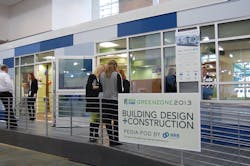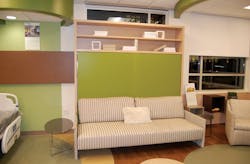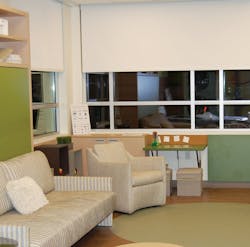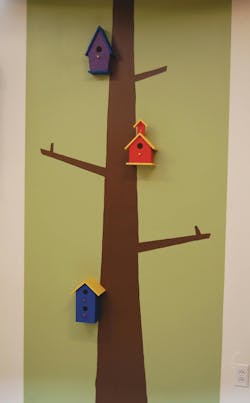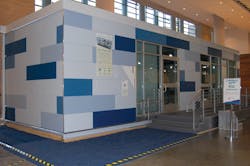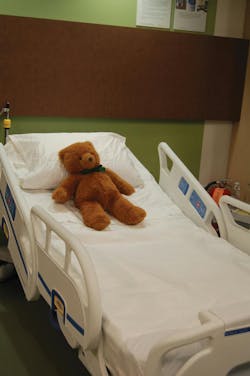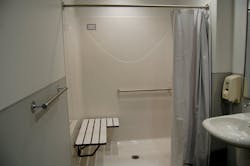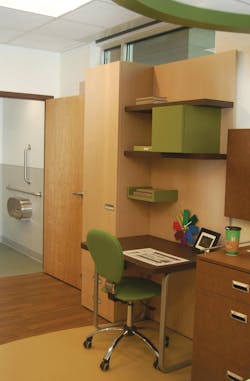Modular Pedia-Pod: Sustainability in healthcare construction [slideshow]
Greenbuild 2013 in Philadelphia was the site of a unique display—Pedia-Pod, a modular pediatric treatment room designed and built by NRB (USA) in Ephrata, Pa., in collaboration with the editors of Building Design+Construction, SGC Horizon LLC, and their team of medical design consultants. More than a thousand Greenbuilders toured the modular unit on November 20 and 21 at the Pennsylvania Convention Center, in Philadelphia.
Off-site construction is gaining momentum and recognition within the AEC and building owner community as a viable alternative to traditional on-site construction methods. Pedia-Pod is a blend of architectural form and medical function that is relevant to the specialized, comforting care needed for the treatment of children.
The Pedia-Pod modular concept, with its sustainable design and construction principles, can be applied to many types of healthcare facility needs, from bathroom pods to physician offices, imaging clinics, ambulatory care centers, and even complete hospitals.
GROWING DEMAND FOR PREFAB IN HEALTHCARE
“We’re definitely seeing an increased demand for prefabricated and modular components being used in the healthcare market sector, especially with large hospital bed expansions and critical access hospitals,” said Allen Post, AIA, an architect with Perkins+Will’s Atlanta office who toured Pedia-Pod. “Whenever there is a lot of repetition, such as a patient bed tower with tens to hundreds of bathrooms, headwalls, and ceiling components, or rural area hospitals with a limited local construction labor force, off-site fabrication becomes a viable option.”
Post said that solutions that have the potential to reduce construction time and cost while improving quality and safety are becoming more accepted practices in the healthcare sector. “The Pedia-Pod prototype is an example of what off-site construction can achieve within the healthcare market,” he said.
Pedia-pod’s sofa can be converted into a pull-down bed (green area) for a parent who wishes to remain overnight with a hospitalized child.
Pedia-Pod combines green products with an efficient off-site construction process, creating a high level of sustainability.
Structural steel framing, steel deck, and steel stud infill lend durability to the building as well as a very high amount of recycled content. The building envelope contains closed-cell spray foam insulation with recycled content in the roof and floor, Greenguard-certified sustainable insulation in the walls, a specialized weather/rainscreen barrier, lightweight cement board subfloor, and mold- and moisture-resistant wall sheathing with 95% recycled content.
The structure has a white roof membrane with an SRI index of 99. The exterior cladding is a handsome architectural fiber cement panel containing Forest Stewardship Council–certified wood pulp and fly ash waste from landfills.
A unique interior drywall product actively removes harmful VOCs from the air, while another drywall component attenuates noise; both are moisture- and mold-resistant. The interior paint is a zero-VOC formula, and the floor finish is a long-lasting, slip-resistant product with recycled content requiring no harsh chemicals for cleaning. Millwork contains FSC-certified board.
The building also features high-performance windows, mechanized shades for daylighting control, energy-efficient lighting and controls, and water-saving plumbing fixtures.
“Building off-site in a controlled environment means better waste management, less vehicular travel, and less disruption at the site,” said Don Engle, General Manager, NRB (USA). “Because Pedia-Pod is one module, it was 100% complete when it left the plant. Once in place, it was set up and ready to go in just hours.”
After Greenbuild, Pedia-Pod was shipped back home to Ephrata and “recycled” for display purposes. Building owners, architects, and contractors will soon be able to tour the structure to see the level of complex features, finishes, and building science technology that off-site construction can bring to the healthcare and commercial/institutional construction markets.
For more on the Pedia-Pod, visit: http://www.bdcnetwork.com/greenzone2013/index.html
